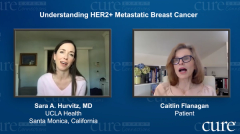
Understanding HER2+ Metastatic Breast Cancer
Sara A. Hurvitz, M.D., reviews the history of HER2+ breast cancer and the progressive research that has been done in this disease.
Episodes in this series

Sara A. Hurvitz, M.D.: Let’s move more into your story, because it is an interesting one. You came to me five years after your original diagnosis of early stage, curable breast cancer. You now had liver metastases and lung metastases. You were still a young mother with young children. We started you on a regimen of chemotherapy called TCH, so docetaxel, carboplatin, and trastuzumab, otherwise known as Herceptin. I think it was after the third cycle that we did a scan and your disease was completely gone. We couldn’t see it on the scan anymore. We finished that out, and we put you on just the maintenance Herceptin. You just had to come in for the antibody that targets HER2 [human epidermal growth factor receptor 2] every three weeks.
Along the way, I think we talked about how great the response was but that this didn’t mean you were cured. We knew at some microscopic level the cancer was still hanging out. While perhaps it’s cured—maybe there’s a 1% or 2% chance—we don’t want to take that chance by stopping therapy, and so you continued to come in. How did you feel about this possibility that the cancer would recur? Recur isn’t the right term. We use the term progress because when it’s stage 4, we never think it’s going to completely go away, so we say the disease is most likely going to progress at some point. It’s going to become resistant to the therapy you’re on, and you’re going to have disease progression. Did we talk about that in those months and early years?
Caitlin Flanagan: I don’t know if we specifically spoke of it that way, but I was seeing you regularly, getting my scans, getting the Herceptin, and I was having my blood taken. I was very aware that we were in the process of ensuring that it didn’t progress without our knowing it. With any cancer, the more years you get away from the diagnosis, the more and more and more you think, “Maybe I got away with something here.” It was nine or 10 years of not having any problem. Then people would find out and be shocked. I remember seeing a gynecologist a few years before this progression.
With any doctor I saw, if I put on the form a medical history of breast cancer, stage 4, they would stop the appointment. “What happened? I need to know. You’re still alive? That’s incredible.” You’d think, “That’s great, but could I get a Pap smear?” They would be so distracted, but it was their reaction. Their reaction was almost what let me know that I was still in a serious situation, because they were so amazed that I was still alive after a metastatic diagnosis. So I knew that’s what we were looking for and what we were protecting against, but I kind of thought I had escaped.
Sara A. Hurvitz, M.D.: Right. It’s interesting. At one of the conferences this past fall, this woman presented data from France. There are 18 comprehensive cancer centers in France that have collected data starting in 2008 through 2017 of every person diagnosed with metastatic breast cancer. They collected data from over 20,000 women. They excluded men, so it was all women. They looked at the different subtypes. They looked at the outcomes, how long the patients were living based on whether they had triple-negative disease, hormone receptor-positive, HER2-negative or HER2-positive breast cancer. There were somewhere around 4,000 patients with HER2+ breast cancer there.
It’s interesting, because I started out this talk by explaining that HER2+ breast cancer has been associated with one of the poorest prognoses. When the alteration was discovered in the 1980s by my boss and mentor, [Dennis] Slamon, M.D., Ph.D.,] it was the worst breast cancer. It was along the lines of triple negative.
In this analysis, they looked at the median overall survival for a person diagnosed in 2008 with metastatic breast cancer. They looked at each year from 2008 through 2017 to find the median time, meaning half the patients were still alive and half were no longer alive. For triple-negative breast cancer, the median overall survival in 2008 was about a year. If you go to 2017, it’s still about a year, so no improvements. Interestingly, hormone receptor-positive was also stable with very flat curves. But HER2+ breast cancer started around 35-38 months and is now upward of 58 months. That was as of 2015, so we haven’t even gotten to the median overall survival for a person diagnosed in 2015, ’16, ’17, and so on.
We know that patients are living longer now with this subtype of breast cancer, metastatic breast cancer, than any other subtype because of the therapies we have available. We also know from studies that women with HER2+ breast cancer are able to receive many more lines of therapy. Meaning that when their disease progresses, which it will do at some point—and you can talk about that a bit in a moment—we have other options to provide them that will get the disease under control again until their disease becomes resistant again. It’s an incurable, chronic disease with bumps and with progression. It’s like hurdles you have to get over along the way. When I was in medical school, we were told that if you have metastatic cancer, you basically treat with one or two treatments and then you call hospice. It isn’t that way with this type of cancer.
Transcript edited for clarity.





